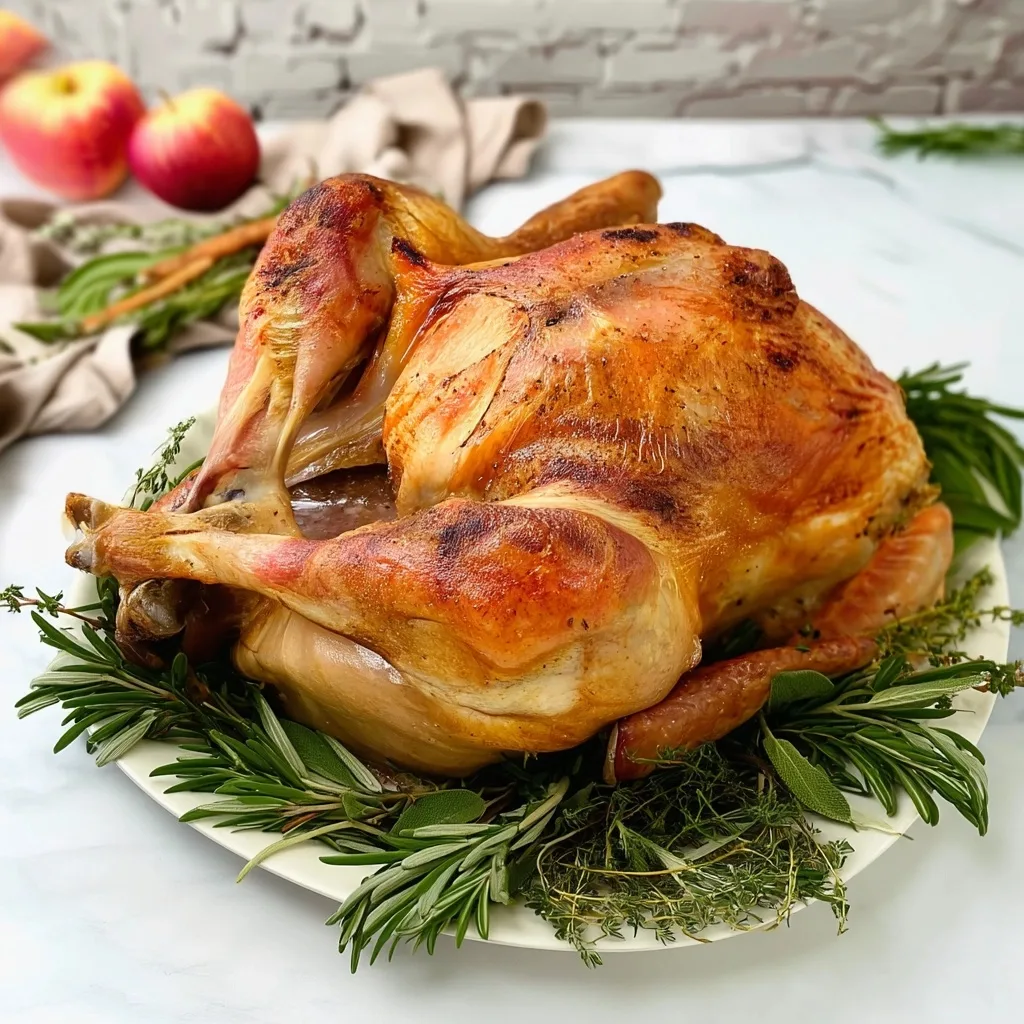There’s nothing quite like the aroma of a perfectly roasted turkey filling your home during the holidays. This classic roast turkey recipe transforms what many consider a daunting culinary challenge into an achievable masterpiece that’ll have your guests raving for years to come. Furthermore, mastering this classic roast turkey technique opens the door to countless memorable family gatherings and holiday celebrations.
The beauty of this classic roast turkey lies not just in its stunning presentation, but in the layers of flavor that develop through proper technique and quality ingredients. Moreover, once you understand the fundamentals of roasting turkey, you’ll gain the confidence to tackle any holiday meal with grace and expertise.
Why This Classic Roast Turkey Recipe Will Transform Your Holiday Cooking
What sets this classic roast turkey apart from countless other recipes is its focus on simplicity paired with proven techniques. Rather than overwhelming you with complicated procedures, this method emphasizes quality ingredients and time-tested approaches that deliver consistent, restaurant-quality results every single time.
The herb-butter technique creates an incredibly flavorful and moist bird that’s virtually foolproof. Additionally, the aromatic vegetable bed not only infuses the turkey with additional flavor but also provides the foundation for an incredible pan gravy that’ll elevate your entire meal.
Unlike dry, flavorless turkeys that dominate many holiday tables, this classic roast turkey delivers succulent meat with crispy, golden skin that photographs beautifully and tastes even better. Furthermore, the recipe includes professional tips that ensure success, even for first-time turkey roasters.
Understanding the Anatomy of Perfect Classic Roast Turkey
Creating an exceptional classic roast turkey requires understanding what makes turkey special and challenging. Turkey breast meat cooks faster than dark meat, creating the classic dilemma of achieving perfectly cooked thighs without overcooking the breast. However, this recipe addresses that challenge through strategic herb-butter placement and proper roasting techniques.
Size Considerations: A 12-14 pound turkey serves approximately 8-10 people generously, with plenty left for sandwiches and soup. This size also cooks more evenly than larger birds, reducing the risk of dry breast meat while ensuring food safety throughout.
Fresh vs. Frozen: While frozen turkeys work perfectly well, fresh turkeys often have superior texture and flavor. If using frozen, ensure complete thawing – approximately 24 hours per 4-5 pounds of turkey in the refrigerator.
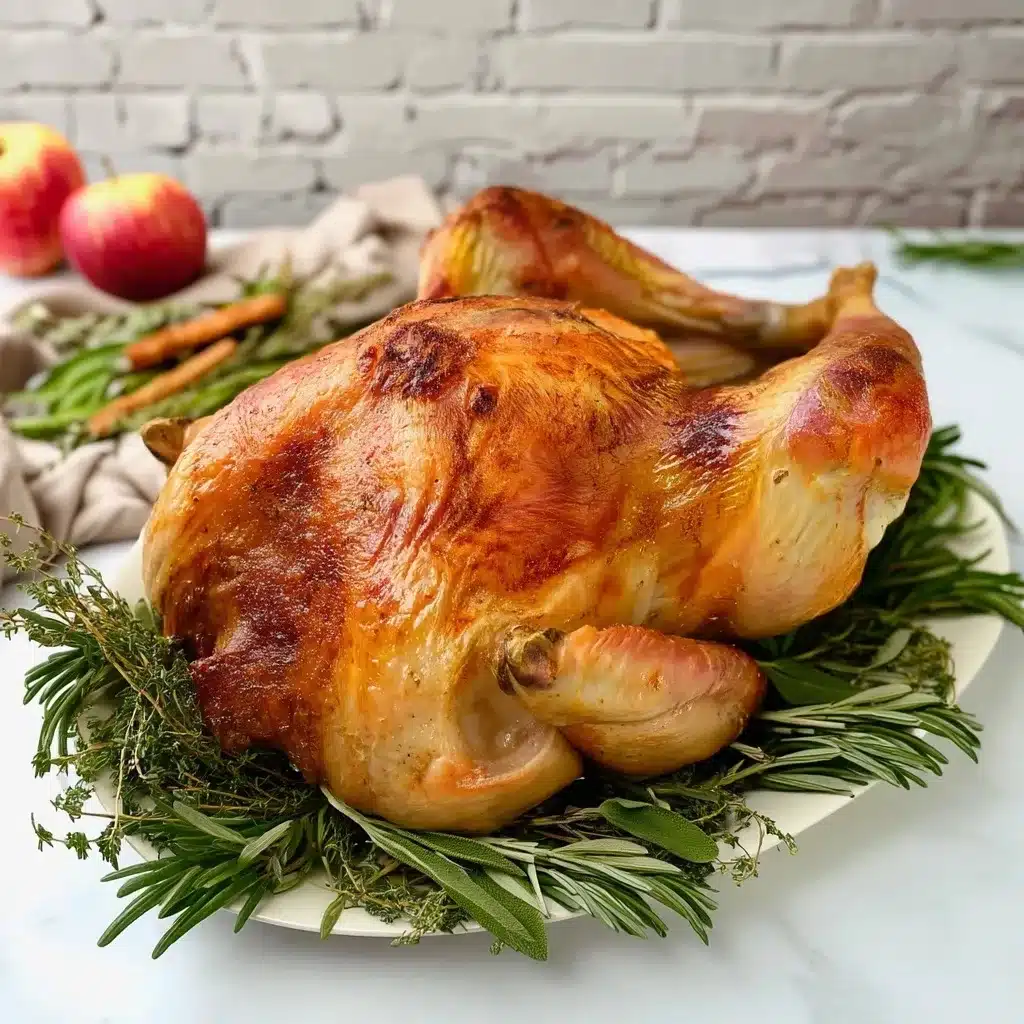
Essential Ingredients for Exceptional Classic Roast Turkey
The Foundation: Quality Turkey Selection
Choosing the right turkey sets the stage for your classic roast turkey success. Look for turkeys with plump breasts, smooth skin, and no off odors. Heritage breed turkeys offer superior flavor, while conventional turkeys provide reliable results and broader availability.
Free-Range vs. Conventional: Free-range turkeys typically have more developed flavors and firmer textures due to increased activity. However, conventional turkeys can be equally delicious when properly prepared and are often more budget-friendly for large gatherings.
The Herb-Butter Mixture: Flavor Innovation
The herb-butter combination transforms ordinary turkey into extraordinary classic roast turkey. Fresh herbs are absolutely essential – dried herbs simply cannot provide the vibrant flavors and aromatic oils that fresh herbs contribute to the final dish.
Thyme: Provides earthy, slightly floral notes that complement turkey’s natural flavor without overwhelming it. Moreover, thyme pairs beautifully with the other Mediterranean herbs in this blend.
Rosemary: Adds piney, robust flavors that create depth and complexity. Use rosemary sparingly, as its potent flavor can dominate if overused. Furthermore, chopping rosemary finely prevents tough, woody pieces in the final dish.
Sage: The quintessential poultry herb that’s been pairing with turkey for centuries. Its slightly bitter, savory notes balance the richness of butter and complement the turkey’s natural flavors perfectly.
The Aromatic Vegetable Foundation
The vegetable bed serves multiple crucial purposes in this classic roast turkey recipe. These vegetables create an aromatic steam that flavors the turkey from below while preventing the bottom from burning. Additionally, they form the flavor base for exceptional pan gravy.
Yellow Onions: Provide sweet, caramelized flavors as they cook slowly in the turkey drippings. The natural sugars in onions also contribute to beautiful browning and rich gravy color.
Carrots and Celery: These classic mirepoix vegetables add vegetable sweetness and create a well-rounded flavor foundation. They also provide essential aromatic compounds that infuse the turkey during the long roasting process.
Garlic and Lemon: These bright, acidic elements balance the rich turkey flavors while adding complexity. The lemon also helps tenderize the meat through natural enzymatic action.
Step-by-Step Guide to Classic Roast Turkey Mastery
Preparation: Setting the Foundation for Success
Proper preparation separates mediocre turkeys from exceptional classic roast turkey results. Begin by thoroughly patting the turkey dry with paper towels – this step is crucial for achieving crispy skin. Moisture is the enemy of browning, so take time to ensure the turkey is completely dry inside and out.
Remove the neck and giblets from both the main cavity and the neck cavity. Save these for stock or gravy if desired. Additionally, check for any remaining pin feathers and remove them with tweezers for the most professional presentation.
Temperature Timing: Remove your turkey from the refrigerator 30-60 minutes before cooking to allow it to come closer to room temperature. This promotes more even cooking and reduces the total roasting time.
Creating the Perfect Herb-Butter Mixture
The herb-butter technique elevates this classic roast turkey from good to extraordinary. Ensure your butter is properly softened – it should yield easily to pressure but not be melted. Room temperature butter incorporates herbs evenly and spreads smoothly under the skin.
Mixing Technique: Combine all herbs, salt, pepper, and butter in a small bowl. Mix thoroughly until herbs are evenly distributed throughout the butter. The mixture should have a uniform green color with no streaks of plain butter visible.
Under-Skin Application: Gently loosen the skin over the breast and thighs by carefully sliding your hand between the skin and meat. Work slowly to avoid tearing the skin. Spread half the herb-butter mixture directly onto the meat, ensuring even coverage for consistent flavor throughout.
Aromatic Bed Preparation and Assembly
Creating the aromatic vegetable bed requires strategic placement for maximum flavor impact. Cut vegetables into uniform 2-inch pieces to ensure even cooking and prevent burning. The vegetables should cover the bottom of the roasting pan in a single layer.
Liquid Management: Pour chicken broth around, not over, the vegetables. The broth creates steam while the vegetables provide elevation, preventing the turkey from sitting in liquid, which would prevent proper browning.
Pan Selection: Use a heavy-bottomed roasting pan that’s large enough to accommodate the turkey without crowding. Proper air circulation around the turkey is essential for even browning and cooking.
Trussing Techniques for Even Cooking
Proper trussing ensures your classic roast turkey cooks evenly and presents beautifully. Tuck wing tips under the body to prevent them from burning during the long cooking process. This also creates a more compact shape that roasts more uniformly.
Leg Tying: Tie the legs together with kitchen twine to maintain the turkey’s shape and promote even cooking. Properly trussed turkeys also carve more easily and present more professionally.
Seasoning the Cavity: Don’t forget to season the inside cavity with salt and pepper. This internal seasoning adds another layer of flavor that penetrates the meat during cooking.
The Science of Perfect Classic Roast Turkey Roasting
Temperature Control and Timing
Roasting at 325°F strikes the perfect balance between cooking the turkey thoroughly and achieving beautiful browning. Higher temperatures can cause the outside to brown too quickly while leaving the inside undercooked. Conversely, lower temperatures extend cooking time unnecessarily and may not achieve the desired skin crispiness.
Cooking Time Calculations: Plan approximately 15 minutes per pound for unstuffed turkeys. However, temperature, not time, determines doneness. Always use a reliable instant-read thermometer to ensure food safety and optimal texture.
Basting Strategy: Baste every 45 minutes with accumulated pan juices. This keeps the skin moist and promotes even browning. However, avoid opening the oven door too frequently, as this extends cooking time and can cause uneven results.
Temperature Monitoring for Food Safety
The most critical aspect of classic roast turkey preparation is achieving proper internal temperature. Insert your thermometer into the thickest part of the thigh, avoiding bone contact. The turkey is done when this area reaches 165°F consistently.
Temperature Zones: Breast meat cooks faster than thigh meat, so monitoring the thigh ensures the entire turkey reaches safe temperatures. The breast will typically reach 165°F when the thigh hits the target temperature.
Carryover Cooking: Turkey continues cooking during the resting period due to residual heat. Remove the turkey when it reaches 160-162°F, as it will continue cooking to 165°F during rest.
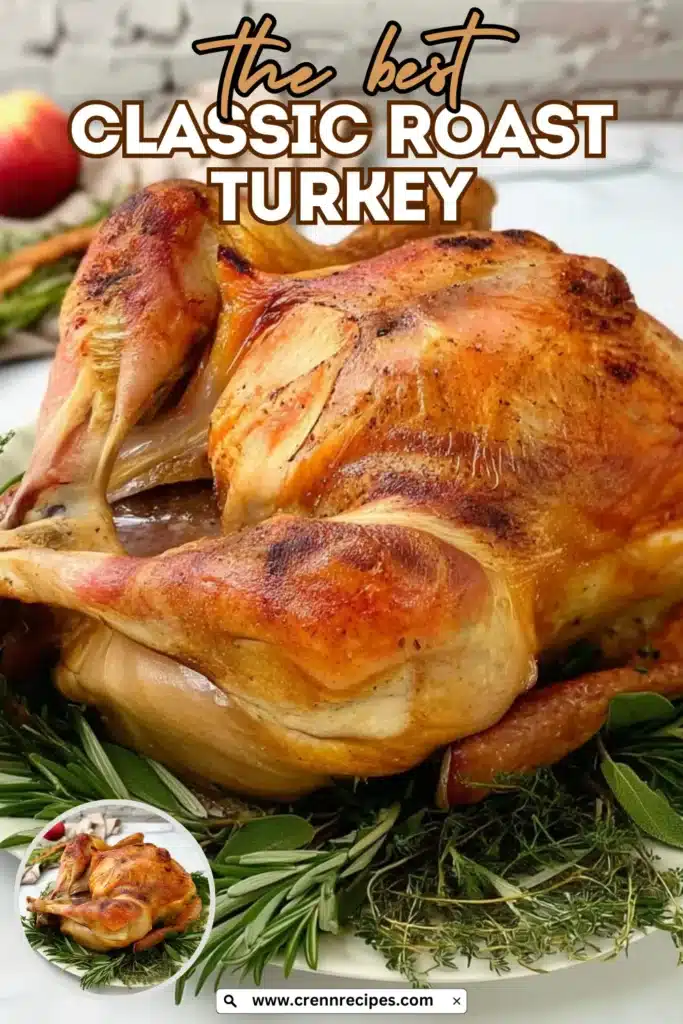
Resting and Carving Your Classic Roast Turkey
The Critical Resting Period
Never skip the resting period when preparing classic roast turkey. This 20-30 minute rest allows juices to redistribute throughout the meat, preventing them from running out when carved. Properly rested turkey is noticeably more moist and flavorful than turkey carved immediately.
Tenting Technique: Cover the turkey loosely with aluminum foil during resting. The foil retains heat while allowing some steam to escape, preventing the skin from becoming soggy while maintaining optimal serving temperature.
Temperature Retention: A properly rested turkey will remain hot enough for serving even after 30 minutes. The large mass retains heat effectively, and the internal temperature may actually continue rising slightly during the initial resting period.
Professional Carving Techniques
Proper carving transforms your beautiful classic roast turkey into elegant serving portions. Begin by removing the legs and thighs in one piece, cutting through the skin between the leg and body, then popping the joint to locate the natural separation point.
Breast Carving: Remove the entire breast in one piece by cutting along the breastbone, then slice against the grain into even portions. This technique produces cleaner slices and more professional presentation than attempting to carve directly on the bird.
Wing Removal: Remove wings at the joint after removing the breast meat. Wings can be served whole or broken down into drumettes and flats for easier eating.
Advanced Tips for Classic Roast Turkey Excellence
Flavor Enhancement Techniques
Dry Brining: For next-level classic roast turkey, consider dry brining 24-48 hours in advance. Salt the turkey inside and out, then refrigerate uncovered. This technique seasons the meat deeply while drawing out moisture for crispier skin.
Aromatics in Cavity: Place lemon halves, herb sprigs, or quartered onions in the turkey cavity for additional flavor infusion. These aromatics steam during cooking, subtly flavoring the meat from inside.
Compound Butter Variations: Experiment with different herb combinations in your butter mixture. Tarragon, marjoram, or even citrus zest can create unique flavor profiles while maintaining the classic technique.
Troubleshooting Common Issues
Uneven Browning: Rotate the turkey halfway through cooking if your oven has hot spots. Additionally, tent specific areas with foil if they’re browning too quickly.
Dry Breast Meat: This usually results from overcooking. Use a reliable thermometer and remove the turkey as soon as it reaches temperature. The herb-butter technique in this recipe specifically addresses this common problem.
Soggy Skin: Ensure the turkey is completely dry before cooking, and avoid over-basting. If skin seems to be softening, increase oven temperature to 375°F for the final 15-20 minutes of cooking.
Make-Ahead Strategies for Stress-Free Holidays
Preparation Timeline
Two Days Before: Prepare herb butter and store covered in refrigerator. If dry brining, salt the turkey and refrigerate uncovered.
Day Before: Prep all vegetables and store in refrigerator. Remove turkey from refrigerator 30-60 minutes before cooking to come to room temperature.
Day Of: Apply herb butter, arrange vegetables, and begin roasting according to timeline. Allow plenty of time – it’s better to finish early than run late for hungry guests.
Storage and Leftover Management
Properly stored classic roast turkey leftovers remain delicious for 3-4 days refrigerated. Store in shallow containers to promote quick cooling and prevent bacterial growth. Additionally, separate light and dark meat for optimal storage and reheating.
Reheating Techniques: Add a splash of chicken broth when reheating to maintain moisture. Cover tightly and reheat gently to prevent drying out the meat.
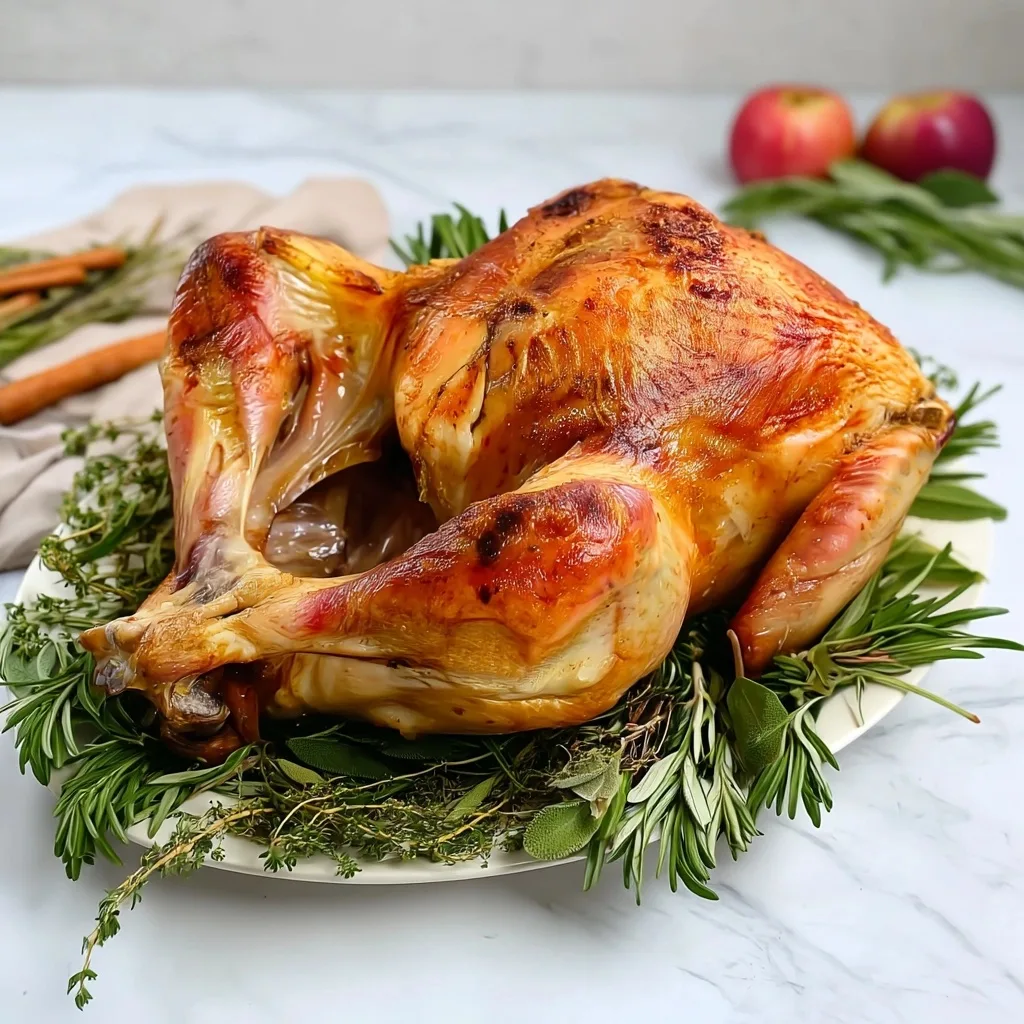
Seasonal Variations and Creative Adaptations
Holiday Flavor Profiles
Thanksgiving Classic: The herb combination in this recipe perfectly captures traditional Thanksgiving flavors. The sage, thyme, and rosemary trio has been seasoning holiday turkeys for generations.
Christmas Variation: Add orange zest to the herb butter and place orange quarters in the cavity for a festive citrus note that pairs beautifully with cranberry sauce and holiday sides.
Spring Adaptation: Substitute fresh tarragon and chives for a lighter, more delicate flavor profile perfect for Easter or spring celebrations.
Regional Influences
Southern Style: Add a touch of paprika and cayenne to the herb butter for subtle heat and color that complements traditional Southern holiday sides.
Mediterranean Influence: Include fresh oregano and lemon zest in the herb mixture, and add olives to the vegetable bed for Mediterranean flair.
European Touch: Incorporate fresh marjoram and bay leaves for a more European herb profile that pairs beautifully with root vegetables and hearty sides.
Pairing Your Classic Roast Turkey with Complementary Dishes
Traditional Side Dishes
The beauty of classic roast turkey lies in its versatility with side dishes. Traditional pairings like mashed potatoes, stuffing, and cranberry sauce complement the herb flavors perfectly while providing textural contrast.
Starchy Sides: Creamy mashed potatoes provide a perfect canvas for turkey gravy, while roasted root vegetables echo the aromatic vegetable bed flavors.
Fresh Elements: Green bean casserole or roasted Brussels sprouts add color and freshness that balance the rich turkey flavors.
Gravy and Sauce Pairings
The pan drippings from this classic roast turkey create an exceptional foundation for gravy. The concentrated flavors from the aromatic vegetables and herbs create complexity that’s impossible to achieve with store-bought alternatives.
Simple Pan Gravy: Strain the drippings, remove excess fat, and whisk with flour and additional stock for smooth, flavorful gravy that complements without competing with the turkey.
Cranberry Accompaniments: Traditional cranberry sauce provides tartness that cuts through the rich turkey flavors while adding festive color to the plate.
More Related Recipes You Might Enjoy
If you’re planning a memorable holiday feast featuring this classic roast turkey, you’ll want to explore these other show-stopping recipes that share similar comfort food appeal and impressive presentation:
- Smoky Bourbon BBQ Bacon Wrapped Meatloaf Cupcakes – Another impressive main dish that combines classic comfort food with creative presentation
- Christmas Stuffed Shells – A festive pasta dish perfect for holiday entertaining and special occasions
- Bourbon Maple Brisket Grilled Cheese – Transform leftover holiday flavors into an incredible comfort food sandwich
Wine and Beverage Pairings
Traditional Wine Selections
Classic roast turkey pairs beautifully with both white and red wines, depending on your preference and the accompanying sides. Pinot Noir offers enough body to complement the herb flavors without overwhelming the delicate turkey meat.
White Wine Options: Chardonnay, particularly oak-aged versions, provides richness that matches the herb-butter preparation while offering enough acidity to cut through the turkey’s natural richness.
Sparkling Choices: Champagne or quality sparkling wine creates a festive atmosphere while cleansing the palate between bites of rich holiday food.
Non-Alcoholic Alternatives
Sparkling Cider: Apple cider, whether sparkling or still, offers seasonal flavors that complement the herb-roasted turkey beautifully.
Cranberry Beverages: Cranberry juice or sparkling cranberry drinks echo traditional thanksgiving flavors while providing refreshing contrast.
Final Thoughts on Classic Roast Turkey Mastery
This classic roast turkey recipe represents the perfect intersection of tradition and technique, delivering results that honor holiday customs while embracing modern understanding of proper cooking methods. The herb-butter technique ensures moist, flavorful meat, while the aromatic vegetable bed creates complexity that elevates the entire dish.
What makes this classic roast turkey truly special is its accessibility. While the results are impressively professional, the techniques are straightforward enough for home cooks of any skill level. Moreover, the recipe provides a solid foundation that can be adapted for different flavor preferences and dietary needs.
The key to classic roast turkey success lies in understanding that great cooking is about patience, proper technique, and quality ingredients rather than complicated procedures. This recipe embodies those principles, creating a turkey that’s worthy of your most important celebrations.
Remember that cooking is ultimately about bringing people together and creating memories. This classic roast turkey provides the centerpiece for those gatherings, but the real magic happens when family and friends gather around the table to share the meal you’ve lovingly prepared.
Don’t be intimidated by the prospect of roasting a whole turkey. With proper preparation, reliable techniques, and attention to detail, you’ll create a classic roast turkey that becomes the foundation for countless cherished holiday memories.
Print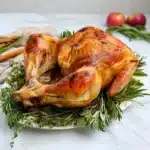
Classic Roast Turkey: Ultimate Holiday Recipe Guide
- Total Time: 4 hours
- Yield: 8–10 servings 1x
- Diet: Gluten Free
Description
A traditional classic roast turkey featuring herb-butter preparation for crispy golden skin and juicy, flavorful meat. Perfect for Thanksgiving, Christmas, and special holiday celebrations with foolproof techniques for consistent results.
Ingredients
- 1 (12–14 lb) whole turkey, neck and giblets removed
- ½ cup (1 stick) unsalted butter, softened
- 2 teaspoons kosher salt, plus more for seasoning
- 1 teaspoon freshly ground black pepper
- 1 tablespoon fresh thyme leaves, chopped
- 1 tablespoon fresh rosemary needles, chopped
- 1 tablespoon fresh sage, finely chopped
- 1 large yellow onion, quartered
- 1 large carrot, cut into 2-inch pieces
- 2 celery stalks, cut into 2-inch pieces
- 4 garlic cloves, smashed
- 1 lemon, halved
- 2 cups low-sodium chicken broth (plus extra if needed)
Instructions
- Prep the Bird & Oven: Preheat oven to 325°F. Pat turkey completely dry inside and out with paper towels.
- Herb-Butter Love: Combine softened butter, thyme, rosemary, sage, 2 tsp salt, and 1 tsp pepper. Loosen skin over breast and thighs, smear half the herb-butter under skin. Rub remaining butter over outside.
- Aromatic Bed: Place onion, carrot, celery, garlic, and lemon in roasting pan. Pour in 1 cup chicken broth.
- Truss & Season: Tuck wing tips under body, tie legs together with kitchen twine. Season cavity with salt and pepper.
- Roasting Time: Place turkey breast-side up on rack. Roast uncovered, basting every 45 minutes with pan juices, until thigh reads 165°F—about 3 to 3½ hours.
- Rest & Carve: Transfer to carving board, tent with foil. Rest 20–30 minutes before carving.
- Serve & Enjoy: Carve and serve with pan juices or make gravy from drippings.
Notes
- Use instant-read thermometer for accuracy – thigh should reach 165°F
- Let turkey rest at room temperature 30-60 minutes before roasting for even cooking
- Save drippings for gravy – strain and remove excess fat before using
- Fresh herbs are essential for best flavor – avoid dried substitutes
- Can dry brine 24-48 hours ahead for even better results
- Prep Time: 30 minutes
- Cook Time: 3-3.5 hours
- Category: Main Dish, Holiday, Thanksgiving, Christmas
- Method: Roasting, Oven
- Cuisine: American, Traditional
Nutrition
- Serving Size: 6 oz turkey with skin
- Calories: 420
- Sugar: 0g
- Sodium: 580mg
- Fat: 24g
- Saturated Fat: 8g
- Unsaturated Fat: 14g
- Trans Fat: 0g
- Carbohydrates: 0g
- Fiber: 0g
- Protein: 45g
- Cholesterol: 165mg

